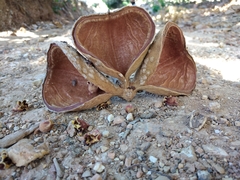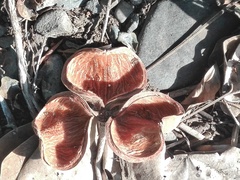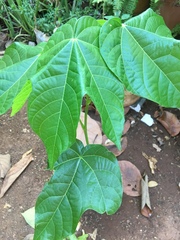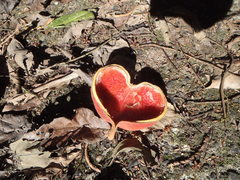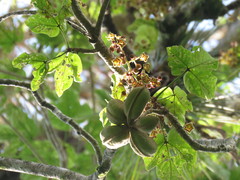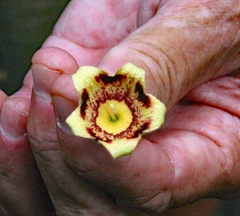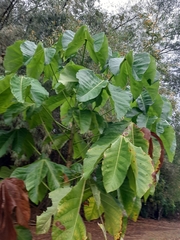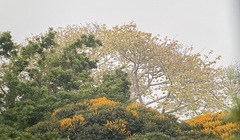

|
|
|
|
Family: Sterculiaceae
Panama-Tree, more...the Panamá tree (es: árbol panamá, Panamá)
|
Description: A tall tree with a large, straight trunk and plant buttresses. Bark is smooth, yellowish. Leaves are large, with five pointed lobes, alternate; juvenile leaves are especially very large. Reproduction: Flowers are produced ___, are whitish with purple spots. Although they technically do not have petals, the sepals look like petals. Fruits____ Distribution: Widespread on the Pacific half of the Canal area, not the Caribbean slope. Occurs widely in secondary forest, old-growth forest, and in residential areas. There are many large trees in Panama City, often near the ocean, and it occurs in all forests from Panama City to Barro Colorado and Soberania. But it's never particularly abundant anywhere, and juveniles are restricted to forest clearings, not seen often in open areas. Similar Species: Juvenile leaves are clearly lobed, and very large, can be mistaken for LK cecrin Cecropia, LK2 or especially LK pourbi Pourouma bicolor. LK2 Leaves of Pourouma and Sterculia have essentially the same shape, but the venation and color of the underside are quite different. Check also leaves of ochrpy balsa and cavapl cuipo, both of which are large and slightly lobed or pointed. Uses: The wood has good quality, and is used for ___. The Panamá is sometimes planted as an ornamental, or in plantation. Descripción: Árbol que alcanza de 10 a 35 m de alto. Copa redondeada y extendida. Tronco con raíces tablares de mediano tamaño en la base. Corteza exterior verde o gris, a veces amarillenta y con manchas blancas. Hojas simples y palmatilobuladas, alternas, con base cordada, lóbulos de 9-20 x 5-10 cm, con ápice agudo y bordes enteros. Estípulas deciduas. Pecíolo de 8-20 cm de largo y pulvinado en la base. Las hojas se encuentran agrupadas en los extremos de las ramitas y generalmente tienen las puntas de los lóbulos dobladas hacia abajo. La especie es monoica. Flores en forma de campana y de color amarillo con morado. Frutos en folículos leñosos, de 8-10 cm de largo, dehiscentes mediante una sutura longitudinal, internamente presentan pelos urticantes de color anaranjado. Semillas oblongas y de color negro. Datos Ecológicos: La especie crece a bajas elevaciones, en lugares secos o húmedos. Común en pastizales y bosques secos de la vertiente del Pacífico en Panamá, pero raro o ausente en bosques lluviosos del Caribe. Deja caer sus hojas durante la estación seca, pero las repone a inicios de la estación lluviosa. Florece y fructifica de diciembre a marzo. Las flores son visitadas por abejas y otros insectos. Las semillas son dispersadas por la abertura de los frutos y los animales. Una chinche del género Dysdercus ataca y destruye las semillas. Especies Parecidas: A menudo se confunde con LK cavapl Cavanillesia platanifolia LK2 , pero en C. platanifolia el tronco tiene anillos circulares y las hojas siempre presentan tres lóbulos, lo cual no ocurre en S. apetala. También se puede confundir con LK pourbi Pouruma bicolor LK2 , pero en P. bicolor el tronco tiene raíces fúlcreas en la base. Usos: La madera es empleada en la fabricación de cajas, cajones, construcciones de interiores, gabinetes, formaletas, ‘plywood’, palillos de fósforos y postes de cercas. La corteza de este árbol se utilizó en el pasado como un remedio contra la malaria. Las semillas contienen gran cantidad de aceite y se pueden comer hervidas o asadas, sí se muelen y colocan en agua se usan para fabricar una bebida fermentada. Los árboles de esta especie se emplean como plantas ornamentales en parques y avenidas, con el tronco se pueden fabricar canoas. Los apicultores lo utilizan como una planta melífera, debido a que las abejas colectan el néctar de las flores. Conforme al decreto de gabinete número 371 del 26 de noviembre de 1969 esta especie fue declarada ‘Árbol Nacional de Panamá’. Functionally monoecious tree, to 40 m tall, to 1 m dbh; outer bark hard, thin, light brown, sandpapery, the lenticels many, closely spaced, raised; inner bark thick, tan, granular; sap with strong, pungent odor. Leaves deciduous; stipules ovate, 5-8 mm long, axillary, caducous; petioles to 25 cm long, densely to sparsely stellate-pubescent; blades deeply and palmately 3-5-lobed, rounded to acute at apex of lobes, cordate at base, to 35 cm long and 45 cm wide, glabrous above except on veins especially near base, softly stellate-arachnoid below to glabrate in age; basal veins usually 5-7, each lobe with 3-7 pinnate veins. Panicles or racemes axillary or subterminal; flowers bisexual or functionally staminate, predominately staminate, with a strong spicy odor; calyx bowl-shaped, greenish, ca 2 cm broad and 1 cm deep, flexible, coriaceous, densely covered outside with short, violet-purple, stellate trichomes, striate and glabrate inside, the lobes acute, recurved; petals lacking; gynophore of staminate flowers hook-shaped, shorter than rim, sparsely glandular-puberulent, also hispidulous at apex; stamens 15, sessile on a raised disk at apex of gynophore; anthers extrorse, dehiscing in bud; pollen +/- tacky; pistil rudimentary, sunken deeply at base of staminal disk, produced above into a slender style, gynophore of pistillate flowers similar and shorter, the staminal disk reduced, the nonfunctional stamens much shorter than the pistil; pistil stellate-tomentulose, 5-carpellate, 5-sulcate, the carpels separating at maturity; style solitary, stout, bent to one side; stigma capitate. Follicles obovoid, to 8 cm long and 5 cm wide, short-tomentose outside, with dense, erect, orangish, stinging trichomes inside, opening very widely along the ventral suture, the periderm woody, 5-7 mm thick; seeds 2-4, oblong-ellipsoid, ca 2 cm long, 1.2 cm diam, covered with trichomes similar to inside of pod, then with a thin, tough, chestnut-brown layer, and then with a thin white layer. Croat 13244. Frequent in the forest. The plant loses its leaves at the beginning of the dry season. After a short span of leaflessness, new leaves are produced. Flowering occurs usually every 2 years and the flowers appear shortly before or shortly after the onset of new leaves, usually in February. The fruits mature about 1 year later, mostly from January to April. Elsewhere in Panama the species may flower twice a year, in November or December and again in March. All fruits on an individual tree dehisce within about 1 month. Those observed by J. Derr (pers. comm.) in Guanacaste, Costa Rica, fell to the ground within 1 week. The seeds are heavily parasitized by cotton stainer bugs (Dysdercus bimaculatus), and any seeds falling beneath the tree are killed by these bugs. Pods that are removed some distance by monkeys, agoutis, or other animals usually have some uneaten seeds discarded because the frugivore becomes distracted by the irritating trichomes lining the pod (Janzen, 1972). In Guanacaste fruit pods are opened by parrots and orange-chinned parakeets and by magpie jays which take the seeds after the pods have opened (J. Derr, pers. comm.). Mexico to Peru and Brazil; West Indies. In Panama, a typical component of tropical dry forest (Holdridge & Budowski, 1956) and of tropical moist forest (Tosi, 1971); known from tropical moist forest in the Canal Zone, San Blas, Panama, and Darien, from tropical dry forest in Coclé, from premontane moist forest in the Canal Zone and Panama, and from premontane wet forest in Chiriqui. Reported from tropical wet forest in Costa Rica (Holdridge et al., 1971). |












